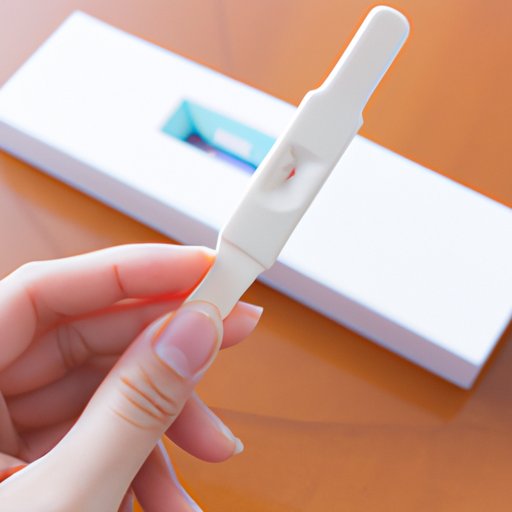Introduction
Pregnancy is the period of time when a woman carries a developing baby inside her uterus. It typically lasts for 40 weeks and is divided into three trimesters. During this time, the pregnant woman’s body will undergo many changes as the fetus grows and develops.
There are many reasons why someone might want to check their own pregnancy at home. Perhaps they are not ready to tell anyone about their situation yet, or maybe they just want to be sure before taking any further steps. Regardless of the reason, it is possible to check your own pregnancy in the comfort of your own home with the help of some simple tools and methods.
This article will provide an overview of how to check your own pregnancy at home. We will explore the various methods and tools you can use to get an accurate result, as well as discuss when to seek medical advice.

Take a Home Pregnancy Test
The most common way to check your own pregnancy at home is to take a home pregnancy test. These tests detect the presence of the hormone human chorionic gonadotropin (HCG) in your urine, which is produced by the placenta shortly after conception. The amount of HCG in your body increases exponentially during early pregnancy, so these tests can give an accurate result as early as one week after conception.
Home pregnancy tests come in two forms: strip tests and digital tests. Strip tests are the most common type and involve peeing on a stick that contains a test strip. Digital tests are slightly more expensive but provide a clearer result. These tests look similar to strip tests but have a digital display that reads “pregnant” or “not pregnant”.
When taking a home pregnancy test, it is important to follow the instructions carefully. Most tests recommend that you use your first morning urine, as this will contain the highest concentration of HCG. It is also important to read the results within the specified timeframe, as the results may become inaccurate if left too long.
Home pregnancy tests are generally very accurate when used correctly. However, false positives and negatives can occur, so it is important to confirm any positive results with a visit to your doctor.

Look for Early Signs and Symptoms of Pregnancy
Another way to check your own pregnancy at home is to look out for the early signs and symptoms of pregnancy. Many women experience some of these signs and symptoms even before they take a home pregnancy test, so this can be a good indicator of whether or not you are pregnant.
Common early pregnancy signs and symptoms include nausea, fatigue, breast tenderness, frequent urination, and missed periods. Some women also experience food cravings and a heightened sense of smell. It is important to note that not all women experience all of these symptoms, and some may not experience any at all.
It is best to look out for these signs and symptoms around the time of your expected period. If you think you may be pregnant and experience any of these signs and symptoms, it is a good idea to take a home pregnancy test or make an appointment with your doctor.
Monitor Your Basal Body Temperature
Your basal body temperature (BBT) is your body’s temperature when you are completely at rest. This temperature tends to increase slightly after ovulation, so tracking your BBT can help you identify when ovulation has occurred and when your period is due.
To take your BBT, you will need a special thermometer known as a basal body thermometer. These thermometers are more sensitive than regular thermometers and can detect smaller changes in temperature. To get an accurate reading, it is important to take your temperature at the same time each morning before getting out of bed.
When tracking your BBT, you should look for patterns over several cycles. If your temperature remains elevated for 18 days or longer, this could indicate that you are pregnant. It is important to note that other factors such as illness and stress can affect your BBT, so it is best to confirm any positive results with a home pregnancy test or a visit to your doctor.
Track Your Periods
If you are trying to determine if you are pregnant, it is a good idea to keep track of your menstrual cycle. This involves noting the dates of your last period, the length of your cycle, and any changes in flow or duration.
Tracking your periods can help you identify when you are most likely to be fertile and when your period is due. This information can also help you to confirm a positive result from a home pregnancy test or a visit to your doctor.
Watch for Changes in Your Breasts
Changes in the size and shape of your breasts can also be an indication of pregnancy. During early pregnancy, your breasts may become larger and more tender. You may also notice darkening of the nipples and veins as the blood vessels in your breasts dilate.
These changes usually occur around the time of your expected period, so it is a good idea to keep an eye out for them. If you experience any of these changes and think you may be pregnant, it is a good idea to take a home pregnancy test or make an appointment with your doctor.

Make an Appointment with Your Doctor
If you think you may be pregnant, it is important to make an appointment with your doctor. They will be able to confirm your pregnancy with a blood test and provide you with advice and support for the next steps.
Making an appointment with your doctor is especially important if you experience any bleeding during early pregnancy, as this could be a sign of a miscarriage or ectopic pregnancy. It is also important to make an appointment if you have any concerns or questions about your pregnancy.
Conclusion
In conclusion, there are a few different ways to check your own pregnancy at home. The most reliable method is to take a home pregnancy test, although it is important to confirm any positive results with a visit to your doctor. Other methods include looking out for early signs and symptoms of pregnancy, monitoring your basal body temperature, and tracking your periods. Finally, it is important to make an appointment with your doctor to confirm your pregnancy and get advice and support.
(Note: Is this article not meeting your expectations? Do you have knowledge or insights to share? Unlock new opportunities and expand your reach by joining our authors team. Click Registration to join us and share your expertise with our readers.)
